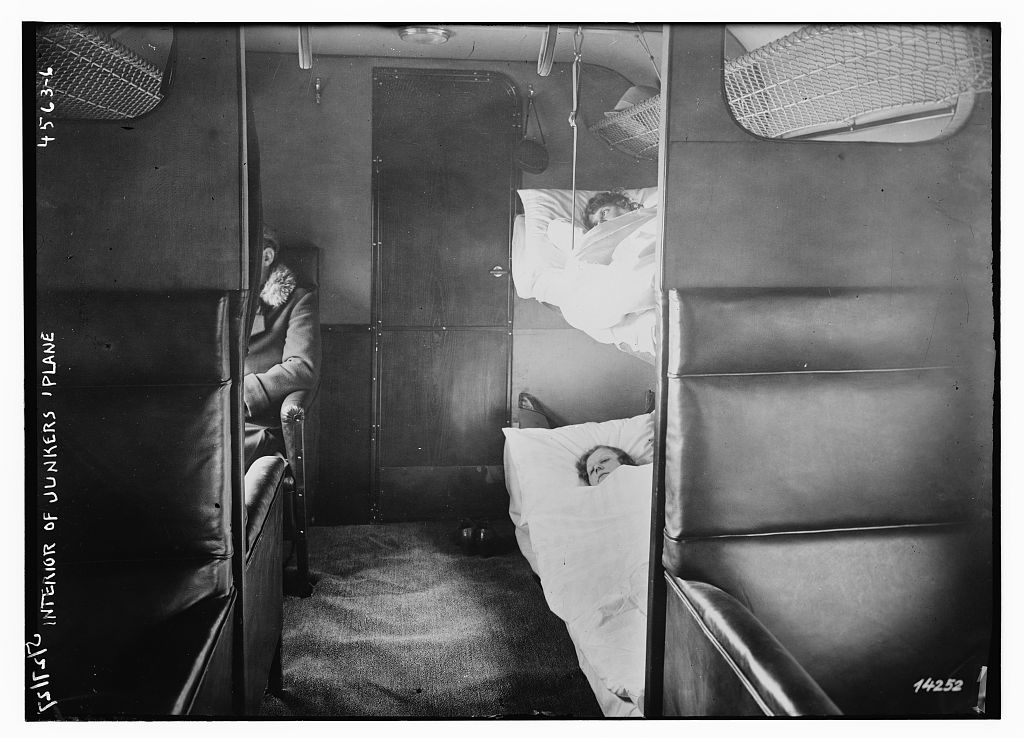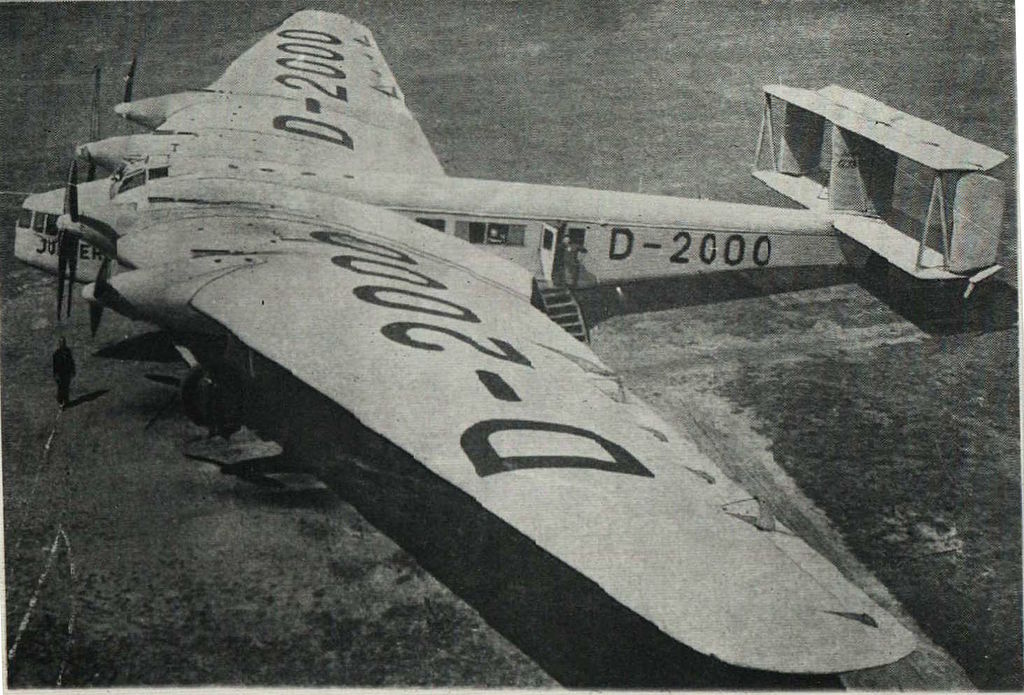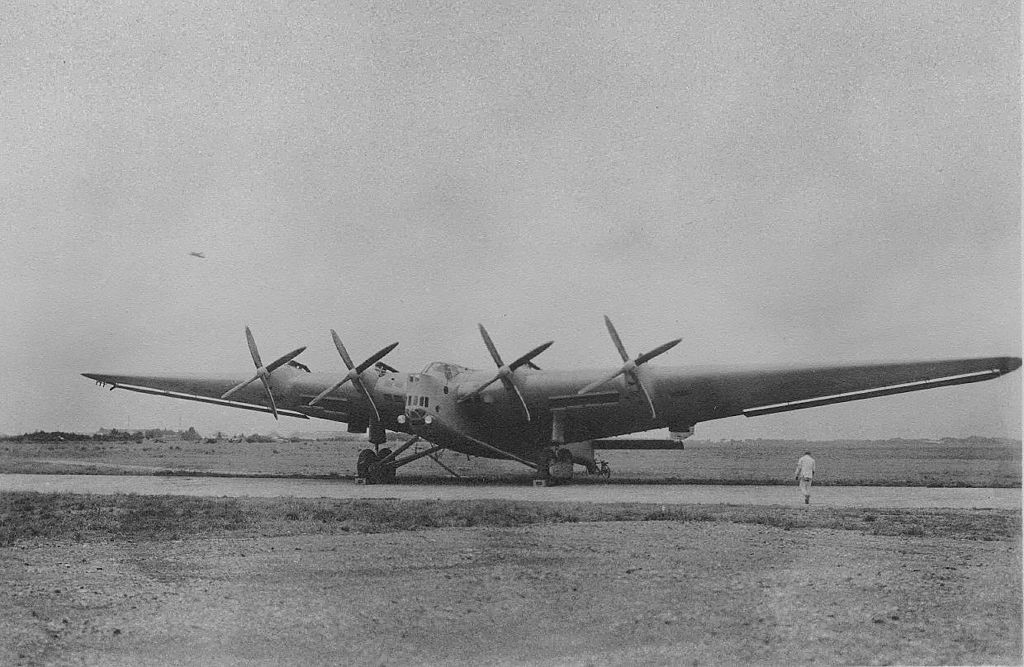The Cruel Sea:
The Junkers G.38
by Mike Bennighof, Ph.D.
August 2022
 While I crafted the Second Great War alternative-history setting to emphasize rigid and rotary flight (airships and helicopters), there was one airplane I wanted to be sure to include: the gigantic Junkers G.38 bomber. The plane plays a major role in Hayao Miyazaki’s wonderful (if heavily fictionalized and sanitized) film The Wind Rises, and I wanted it in my creation too. While I crafted the Second Great War alternative-history setting to emphasize rigid and rotary flight (airships and helicopters), there was one airplane I wanted to be sure to include: the gigantic Junkers G.38 bomber. The plane plays a major role in Hayao Miyazaki’s wonderful (if heavily fictionalized and sanitized) film The Wind Rises, and I wanted it in my creation too.
Hugo Junkers never wanted the G.38 to serve military purposes; he wanted to build a civilian airliner large enough and luxurious enough to compete with the Zeppelin airships then creating a market for air travel. Junkers designed the plane in the late 1920’s with help from his firm’s lead designer, Ernst Zindel, who was drafting the smaller Ju52 airliner at the same time. While Zindel convinced his boss to accept secret military funding to aid the Ju52 project, Junkers sternly rejected efforts to militarize his dream aircraft. German firms could not at the time build military aircraft, a loophole in the Versailles Treaty did allow them to design such planes for the export market, and Junkers authorized Zindel to draft a design study for a bomber/transport version of the plane, designated K.51.
Junkers and Zindel drew inspiration for the huge G.38 from the deep wing concept, which dated back to 1909 and would later form the basis for “flying wing” designs. The plane had very thick wings – 1.7 meters – allowing mechanics to service the four engines during flight. The prototype had diesel engines, later replaced with a more conventional powerplant. Any one of the four engines could be shut down during flight and re-started after maintenance. The wings were swept back and the biplane tail structure had three rudders, a common solution in aircraft designs of the time. Like other Junkers aircraft, the big airplane had a corrugated metal skin.

The first G.38; note forward passenger cabin (and different inner and outer engines).
The deep wings provided enough space for six passengers in two small cabins between the fuselage and the innermost engine of either wing. The wings also carried the fuel tanks, and would have had space for enclosed bomb bays in a militarized version. More passengers rode in the fuselage, on two decks with 11 passengers in each cabin. Two more passengers had seats in the plane’s nose, just below the cockpit, making a total of 30 in addition to a crew of seven.
Passengers in the wings and nose had a broad forward-looking view of their flight, the same as the plane’s pilots. A lavatory and a smoking room were also included in the fuselage; passengers could move about freely during flight and a steward from Mitropa, the German railroad catering firm, looked after their needs. Lufthansa passenger service began in 1931 with one plane; a second was built in 1932.

The G.38 cabin, a relic of the age before the flying sardine can.
The largest airplane in the world when built, the G.38 immediately set records for cargo capacity, hauling five tons’ worth of goods. It was a very slow plane, making just 175 kilometers per hour (109 miles per hour) at cruising speed, with a maximum speed of 225 kilometers per hour (140 miles per hour). But it had a massive take-off weight, making it an excellent cargo hauler, and enormous range, 3,460 kilometers (2,150 miles), which bettered that of the big German passenger zeppelins then dominating the public’s imagination.
The first G.38 crashed in 1936, hitting the ground on takeoff on its way to the Junkers maintenance facility at Dessau. No one was killed, but the plane had to be declared a total loss. The second plane continued in passenger service until the outbreak of war in 1939, when it was pressed into Luftwaffe service as a transport. It carried personnel to Athens in May 1941 during the German invasion of Greece, when an RAF raid caught it on the ground and it also became a total loss.

The G.38 in Bulgaria (D-2000 was the prototype
designation).
In 1928, Mitsubishi of Japan sent a delegation to visit the Junkers facility, an event shown in The Wind Rises. Impressed by the G.38, the engineers convinced the firm to purchase a license for the K.51 militarized design in April 1930. Mitsubishi built two of them in 1932, using parts provided by Junkers, and four more over the next three years, fully manufactured in Japan.
The Japanese engineers found the plane, designated the Type 92 Super Heavy Bomber in Japanese service, to be underpowered and continually worked to fit more powerful engines. The Imperial Army declared the project top secret, and did not acknowledge the plane’s existence. As modified by Mitsubishi, the aircraft had a crew of 10 with six machine guns and a 20mm cannon for defense and carried a bomb load of five metric tons. The machine guns had turrets mounted in the deep wing, with double mounts on the upper side of the outermost engine nacelles and single mounts underneath; the cannon occupied a mount atop the fuselage.

A Ki-20 heavy bomber at Hamamatsu Air Base.
In case of war, the small squadron would have been used to bomb the American fortifications of Manila – Fort Drum and Corregidor – at the outset of hostilities. That mission never took place, as the underpowered plane had been retired from front-line service by then as it was considered far too vulnerable to the increasingly-capable fighter planes fielded by the Americans and other potential enemies. Less than a year after the last plane was delivered the Imperial Army issued requirements for a replacement, resulting in the successful Mitsubishi Ki-21 Sally heavy bomber.
In January 1940 the Imperial Army’s Air Service finally took the wraps off the Type 92, giving it the label Ki-20 and flying three of them over Tokyo in a show of strength. That became the plane’s wartime mission, flying over Japanese cities until American bombers started to appear there instead. One apparently survived the war in the Tokorozawa Aviation Museum but was scrapped after the Japanese surrender.
 In Second Great War at Sea: The Cruel Sea, the Imperial German Luftstreitkräfte operate the G.38 as a heavy bomber. Our game version is based on the K.51 study with more powerful engines in light of the Japanese experience. Few aircraft in the game can match its range and bomb load (the Russians operate a bomber derived from the ANT-20bis, itself heavily influenced by the G.38), and air defense fighters are far less developed than in our reality. In Second Great War at Sea: The Cruel Sea, the Imperial German Luftstreitkräfte operate the G.38 as a heavy bomber. Our game version is based on the K.51 study with more powerful engines in light of the Japanese experience. Few aircraft in the game can match its range and bomb load (the Russians operate a bomber derived from the ANT-20bis, itself heavily influenced by the G.38), and air defense fighters are far less developed than in our reality.
You can order The Cruel Sea right here, right now.
Sign up for our newsletter right here. Your info will never be sold or transferred; we'll just use it to update you on new games and new offers.
Mike Bennighof is president of Avalanche Press and holds a doctorate in history from Emory University. A Fulbright Scholar and NASA Journalist in Space finalist, he has published a great many books, games and articles on historical subjects; people are saying that some of them are actually good.
He lives in Birmingham, Alabama with his wife and three children. He will never forget his Iron Dog, Leopold.
Want to keep Daily Content free of third-party ads? You can send us some love (and cash) through this link right here.
|
